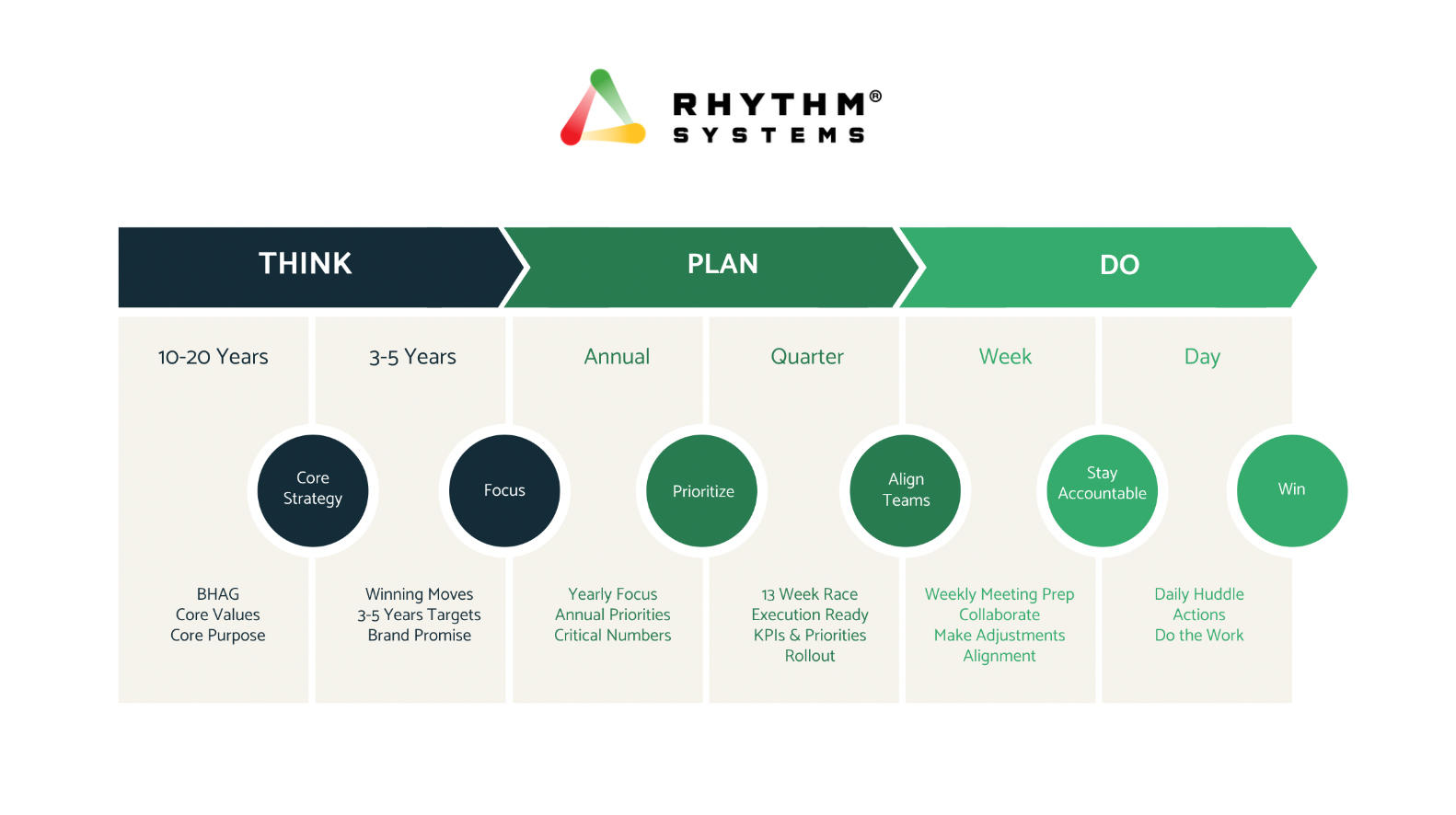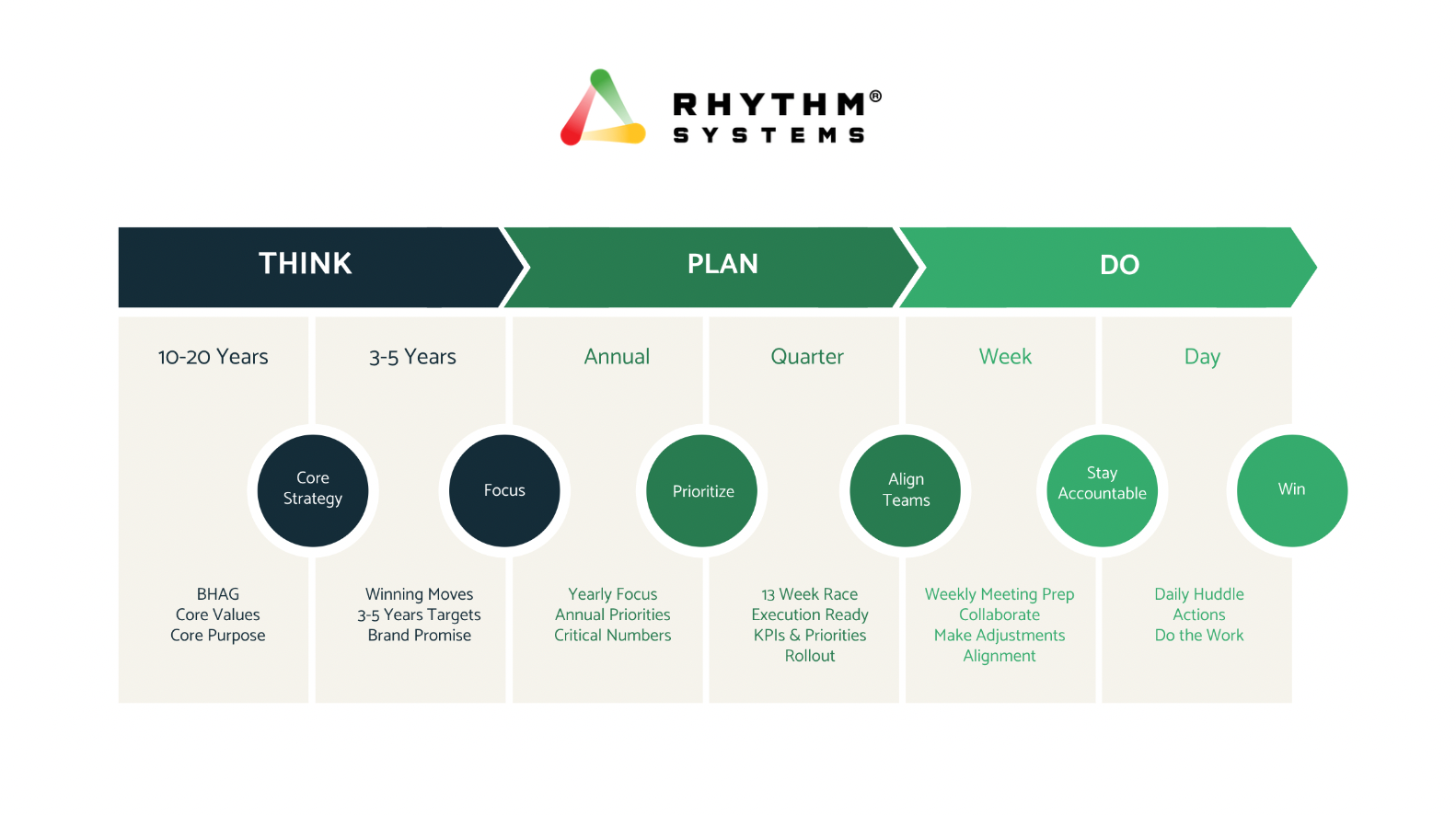In the dynamic world of business, growth is a double-edged sword. While it brings opportunities and prosperity, it also introduces complexity that can be challenging to manage. As a company expands, it becomes increasingly difficult to maintain alignment, drive execution, and sustain growth. However, a proven methodology can help businesses navigate these challenges: the Think, Plan, Do® Rhythms developed by Rhythm Systems.
Why Do I Need a Business Operating System?
A business operating methodology is a structured approach to managing the operations of a business. This methodology provides an organized system for setting goals, establishing processes and procedures, allocating resources, monitoring progress, and measuring and evaluating results. With this system in place, businesses can make informed decisions about how to achieve their desired outcomes.
A business operating methodology helps businesses stay on track and achieve their objectives. With well-defined processes, managing operations and reaching goals effectively is easier. The Think Plan Do® method is a business operating methodology that structures operations and helps businesses stay organized and on track. It encourages a logical, systematic approach to problem-solving, decision-making, and implementation.
Think Plan Do® is based on the notion that there are three fundamental steps in completing any task or achieving any goal: thinking, planning, and doing. Thinking involves gathering information and making sense of it. Planning involves setting objectives, determining strategies, breaking down tasks into manageable steps, and allocating resources. Doing consists of taking action and following through with the plans made during the planning stage.
The Think Plan Do® methodology can help businesses stay organized, create alignment between different departments within an organization, and ensure that everyone is working towards a common goal, annual priority, quarterly rock, and how it rolls up to your BHAG and other long-term objectives.
What is the Think, Plan, Do® Methodology?
The Think, Plan, Do® methodology is a strategic execution system designed to help growing companies implement their strategic plans successfully. It's a simple yet powerful framework that encourages businesses to think about their strategy, plan their execution, and do the work. This iterative process has been proven to drive success for over twenty years.
The Think, Plan, Do® Rhythms, developed by Patrick Thean and Rhythm Systems, is a strategic execution system that helps businesses maintain focus, align their teams, and drive accountability.

The Think Rhythm
Think is the first step in the process. It involves strategic thinking about the business, its goals, and the path to achieving them. This phase is crucial for setting the company's direction and choosing the winning moves to drive growth. It's about understanding the competitive, economic, and political landscape, analyzing opportunities and threats, and brainstorming new revenue-generating ideas. This strategic thinking should be done iteratively, flexing your strategic muscles regularly.
Having Think Rhythm in your organization is essential to staying ahead of the competition and meeting present and future demands. This means strategizing beyond just immediate needs, finding innovative solutions, and focusing on where you can make improvements. By taking a consistent approach to strategic thinking—while allowing teams to question assumptions continuously—you can help create an atmosphere of informed decision-making that will power your business's growth.
Having a Think Rhythm helps ensure that everyone on your team understands what's happening in the industry at any given time and how their work fits into that ever-changing landscape. Regular brainstorming sessions keep ideas flowing and lead to more creative solutions, while consistently questioning current practices encourages open dialogue within teams. Hence, they remain agile enough to respond quickly when industry changes occur. Regular conversations with executives ensure that all team members understand their role in moving toward company goals. A Think Rhythm empowers everyone to stay focused on the organization's future while remaining plugged into project tasks.
The Plan Rhythm
Plan is the next phase, where the strategic ideas from the Think phase are translated into actionable plans. This involves cascading priorities throughout the organization, aligning teams around these priorities, and setting clear, measurable goals. It's about creating a clear roadmap for your teams to follow and ensuring everyone is on the same page. This planning should be done annually and quarterly, allowing your business to stay agile and aligned with your strategic goals.
The planning rhythm is an organizational practice that schedules work and projects to fit the team's objectives. It provides a regular cadence, or pattern of events, for planning and scheduling work. With a plan rhythm in place, everyone on the team knows what's expected of them, when each activity should be completed, and how it fits into the bigger picture.
The core of plan rhythm is creating an operational cadence that makes sense for the team and aligns with their objectives and vision. This could include a daily standup to check task progress, a weekly scrum to review all tasks to ensure they are still relevant, and monthly planning meetings to evaluate performance and adjust plans as needed. Each step should be kept intact so teams can track their progress at every turn while making sure they are staying focused on achieving their goals. In addition to seeing precise results from their efforts, having a plan rhythm also increases team collaboration by helping them identify areas of overlap or opportunities to coordinate tasks better. Plan rhythm can significantly enhance team productivity by clarifying what needs to be done when it needs to be done, and how it fits in with the organization's broader goals.
The Do Rhythm
Do is the final phase, where the plans are executed. This is where the proverbial rubber meets the road. This phase involves doing the work, driving execution, and making necessary adjustments. It's where the rubber meets the road, and the strategic plans become a reality. This involves meeting weekly to review your dashboards, seeing how you are executing towards achieving your goals, and making adjustments if you need to be on track to get your desired results at the end of the quarter. The hard work of your strategic planning bears fruit in your weekly meeting agenda.
The DO Rhythm is an essential component of any successful plan of action. It involves establishing a set of deadlines and ensuring goals are met to stay on track. As humans, having a rhythm of doing the work helps to keep us focused and productive. Scheduling regular breaks is also essential for resetting our minds and allowing us to come back refreshed and better able to tackle whatever task lies ahead.
Having an effective rhythm goes beyond relying on individual motivation, however. In teams or groups, collaboration can create unity around the purpose while streamlining processes. Additionally, defining meeting times or deadlines for tasks and minor deliverables allows everyone involved to quickly adapt their approach to reach the collective goal quickly and with quality results. Planning and using disruptions as learning tools instead of giving up altogether are keys to achieving success while maintaining your rhythm of working towards it.
The Benefits of Powerful Rhythms and Habits
Implementing your organization's Think, Plan, Do® Rhythms brings many benefits. These include:
- Increased organizational alignment and focus: By cascading strategic priorities throughout the organization, everyone is aligned and focused on the same goals.
- Improved accountability and faster course correction: The Do Rhythm encourages accountability and allows for speedier course correction, ensuring your teams stay on track toward their goals.
- Enhanced agility and ability to respond to change: The iterative nature of the Think, Plan, Do® Rhythms allows your organization to be more agile and responsive to changes in the business environment.
- Higher employee engagement: When teams are aligned around shared goals, it boosts engagement and fosters a sense of unity and purpose.
- Faster, more profitable innovation: The Think, Plan, Do® Rhythms encourage proactive adjustments, fostering a culture of innovation where new ideas are welcomed and explored.
The Think, Plan, Do® methodology effectively allows teams to stay organized and on track. It encourages teams to reflect on their strategy before taking action, thus preventing costly mistakes from being made. Additionally, the framework helps foster a culture of innovation by encouraging proactive adjustments and exploring new ideas. By cascading strategic priorities throughout the organization and promoting accountability, this methodology can help boost employee engagement and consistently delivery predictable results.
Implementing the Think, Plan, Do® Rhythm Methodology
The Think, Plan, Do® rhythm methodology is an approach to project management that can help teams stay organized and focused on goals. It emphasizes the need for careful planning and thoughtful consideration before taking action. Groups of all sizes and industries can use this approach, and we have many successful client stories and a double-your-money-back guarantee.
To implement the methodology, it’s essential to understand the three phases: think, plan, and do. During the think phase, teams should brainstorm ideas and collaborate to develop a strategy. During the plan phase, teams should create a plan that details what tasks need to be done, how long they will take, and who is responsible for each task. Finally, during the do phase, teams should execute their plan and make any necessary adjustments.
By dividing projects into these three phases, teams can ensure they are organized and efficient. Additionally, it forces teams to stop and reflect on their strategy during the thinking phase before taking action. This could help prevent costly mistakes if a team were to jump straight into a project without having the proper plan in place.
Rhythm Systems Strategy and Goal Execution Software
Rhythm Systems offers a powerful software solution to support the implementation of Think, Plan, Do® Rhythms and create an accountable team. This software helps teams execute strategic goals, driving alignment and accountability at multiple levels of the organization.
The Rhythm software features a built-in AI goal-writing coach, automated quarterly plan audits, and advanced integration capabilities. It is a single source of truth that drives transparency, connects long-term strategy to daily execution, and allows for proactive adjustments before it's too late.
Key Takeaways and Exec Team Summary of The Rhythm System
Think, Plan, Do® Rhythms offer a robust framework and methodology for businesses to navigate the complexities of growth. By implementing these rhythms, companies can maintain focus, align their teams, and drive accountability, leading to sustained growth and success.
In the face of growing complexity, businesses need a reliable system to drive execution and sustain growth. The Think, Plan, Do® Rhythms offer a proven solution to this challenge. By implementing these rhythms and leveraging the power of the Rhythm Systems software, businesses can navigate the complexities of growth and achieve breakthrough execution. It's time to harness the power of rhythms and propel your business to new heights.
Additional Resources:
5 Best Practices to Manage Remote Employees
Strategic Planning Tips: 17 Tips to Create a Winning Strategic Plan
How to Engage Remote Employees
How to Use Daily Huddles to Stay Aligned with Remote Teams
5 Steps to Having a Productive Virtual Monthly Meeting
Big Hairy Audacious Goals: Classic BHAG Examples (Relevant in 2021)
The Anatomy of a Great Quarterly Plan (Infographic)
Rhythm Systems Quarterly Planning Resource Center



